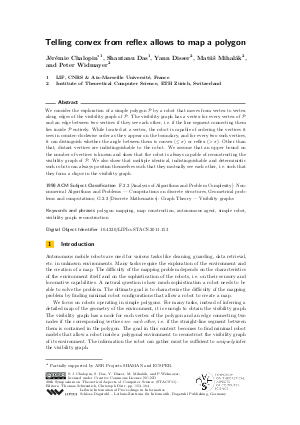Telling convex from reflex allows to map a polygon
Authors Jeremie Chalopin, Shantanu Das, Yann Disser, Matus Mihalak, Peter Widmayer
-
Part of:
Volume:
28th International Symposium on Theoretical Aspects of Computer Science (STACS 2011)
Part of: Series: Leibniz International Proceedings in Informatics (LIPIcs)
Part of: Conference: Symposium on Theoretical Aspects of Computer Science (STACS) - License:
 Creative Commons Attribution-NonCommercial-NoDerivs 3.0 Unported license
Creative Commons Attribution-NonCommercial-NoDerivs 3.0 Unported license
- Publication Date: 2011-03-11
File

PDF
LIPIcs.STACS.2011.153.pdf
- Filesize: 0.7 MB
- 12 pages
Document Identifiers
Subject Classification
Keywords
- polygon mapping
- map construction
- autonomous agent
- simple robot
- visibility graph reconstruction
Metrics
- Access Statistics
-
Total Accesses (updated on a weekly basis)
0Document
0Metadata
Abstract
We consider the exploration of a simple polygon P by a robot that moves from vertex to vertex along edges of the visibility graph of P. The visibility graph has a vertex for every vertex of P and an edge between two vertices if they see each other, i.e.~if the line segment connecting them lies inside $P$ entirely. While located at a vertex, the robot is capable of ordering the vertices it sees in counter-clockwise order as they appear on the boundary, and for every two such vertices, it can distinguish whether the angle between them is convex (<= pi) or reflex (> pi). Other than that, distant vertices are indistinguishable to the robot. We assume that an upper bound on the number of vertices is known and show that the robot is always capable of reconstructing the visibility graph of P. We also show that multiple identical, indistinguishable and deterministic such robots can always position themselves such that they mutually see each other, i.e. such that they form a clique in the visibility graph.
Cite As Get BibTex
Jeremie Chalopin, Shantanu Das, Yann Disser, Matus Mihalak, and Peter Widmayer. Telling convex from reflex allows to map a polygon. In 28th International Symposium on Theoretical Aspects of Computer Science (STACS 2011). Leibniz International Proceedings in Informatics (LIPIcs), Volume 9, pp. 153-164, Schloss Dagstuhl – Leibniz-Zentrum für Informatik (2011)
https://doi.org/10.4230/LIPIcs.STACS.2011.153
BibTex
@InProceedings{chalopin_et_al:LIPIcs.STACS.2011.153,
author = {Chalopin, Jeremie and Das, Shantanu and Disser, Yann and Mihalak, Matus and Widmayer, Peter},
title = {{Telling convex from reflex allows to map a polygon}},
booktitle = {28th International Symposium on Theoretical Aspects of Computer Science (STACS 2011)},
pages = {153--164},
series = {Leibniz International Proceedings in Informatics (LIPIcs)},
ISBN = {978-3-939897-25-5},
ISSN = {1868-8969},
year = {2011},
volume = {9},
editor = {Schwentick, Thomas and D\"{u}rr, Christoph},
publisher = {Schloss Dagstuhl -- Leibniz-Zentrum f{\"u}r Informatik},
address = {Dagstuhl, Germany},
URL = {https://drops.dagstuhl.de/entities/document/10.4230/LIPIcs.STACS.2011.153},
URN = {urn:nbn:de:0030-drops-30077},
doi = {10.4230/LIPIcs.STACS.2011.153},
annote = {Keywords: polygon mapping, map construction, autonomous agent, simple robot, visibility graph reconstruction}
}
